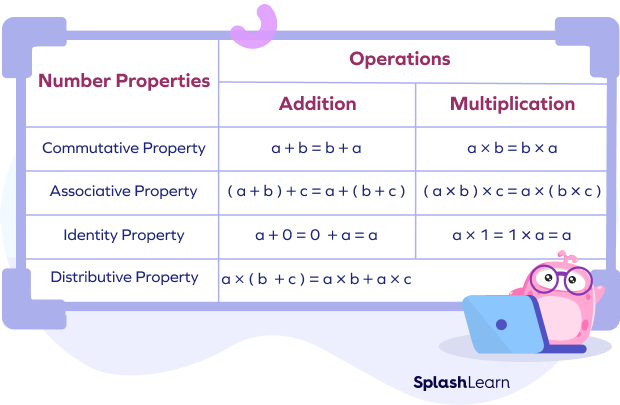Math Properties List

Understanding the properties of mathematics is fundamental to grasping the subject as a whole. Mathematics is built on a set of axioms and theorems that define how mathematical operations behave. Here’s an exhaustive list of key math properties, categorized for clarity:
1. Commutative Property
- Addition: The order of the numbers being added does not change the result. Example: (a + b = b + a)
- Multiplication: The order of the numbers being multiplied does not change the result. Example: (a \times b = b \times a)
2. Associative Property
- Addition: The way numbers are grouped when adding does not change the result. Example: ((a + b) + c = a + (b + c))
- Multiplication: The way numbers are grouped when multiplying does not change the result. Example: ((a \times b) \times c = a \times (b \times c))
3. Distributive Property
- This property distributes a single operation over two other operations. Example: (a \times (b + c) = a \times b + a \times c)
4. Identity Property
- Additive Identity: There exists a number (0) such that when added to any number, the result is the number itself. Example: (a + 0 = a)
- Multiplicative Identity: There exists a number (1) such that when multiplied by any number, the result is the number itself. Example: (a \times 1 = a)
5. Inverse Property
- Additive Inverse: For each number, there exists another number such that when added together, they result in the additive identity (0). Example: (a + (-a) = 0)
- Multiplicative Inverse: For each non-zero number, there exists another number such that when multiplied together, they result in the multiplicative identity (1). Example: (a \times \frac{1}{a} = 1)
6. Closure Property
- Addition: The sum of two numbers is always a number. Example: (a + b) is a number.
- Multiplication: The product of two numbers is always a number. Example: (a \times b) is a number.
7. Transitive Property
- Equality: If (a = b) and (b = c), then (a = c).
- Inequality: If (a < b) and (b < c), then (a < c). Similarly for (>).
8. Symmetric Property
- If (a = b), then (b = a). This property applies to equality but not to inequalities.
9. Reflexive Property
- Every number is equal to itself. Example: (a = a).
10. Antisymmetric Property
- If (a = b) and (a < b), then this is a contradiction, showing that if (a < b), (a \neq b).
These properties form the backbone of arithmetic and are essential in more advanced mathematical operations and theories. Understanding and applying these properties can simplify complex calculations and provide insights into the nature of mathematical structures.
Practical Applications
The properties listed above have numerous practical applications across various fields, including physics, engineering, economics, and computer science. For instance, the distributive property is crucial in algebra for expanding and simplifying expressions, while the commutative property of addition is fundamental in statistical analysis for calculating means and sums.
Theoretical Foundations
Mathematical properties are not just tools for calculation but also serve as the theoretical foundations for advanced mathematical disciplines. The study of these properties and their implications leads to deeper insights into mathematical structures, such as groups, rings, and fields, which are pivotal in abstract algebra.
Educational Significance
Teaching these properties to students is not just about memorization but about fostering a deeper understanding of mathematics. By exploring the implications and applications of these properties, students can develop problem-solving skills, critical thinking, and an appreciation for the elegance and coherence of mathematical concepts.
In conclusion, the properties of mathematics are fundamental principles that underpin all mathematical operations and theories. Understanding these properties is crucial for advancing in mathematics and applying mathematical concepts to real-world problems. Whether in basic arithmetic, advanced algebra, or theoretical mathematics, these properties provide a solid foundation upon which all mathematical knowledge is built.
What is the significance of the commutative property in mathematics?
+The commutative property, which applies to addition and multiplication, signifies that the order of the numbers does not change the result. This property is fundamental in simplifying calculations and is a basic axiom in the development of arithmetic.
How does the distributive property aid in algebraic manipulations?
+The distributive property is crucial in algebra for expanding and simplifying expressions. It allows for the distribution of a single operation over two other operations, making it easier to manipulate and solve equations.
What role do mathematical properties play in the theoretical foundations of mathematics?
+Mathematical properties serve as the theoretical foundations for advanced mathematical disciplines. They lead to insights into mathematical structures and are pivotal in the development of abstract algebra, geometry, and other fields.
How are mathematical properties applied in practical, real-world scenarios?
+Mathematical properties have numerous practical applications across fields such as physics, engineering, economics, and computer science. They are used in statistical analysis, data modeling, and problem-solving, among other applications.
Why is it important to teach mathematical properties in education?
+Teaching mathematical properties is important because it helps students develop a deep understanding of mathematics, fosters problem-solving skills, and encourages critical thinking. It prepares students for advanced mathematical studies and real-world applications.

